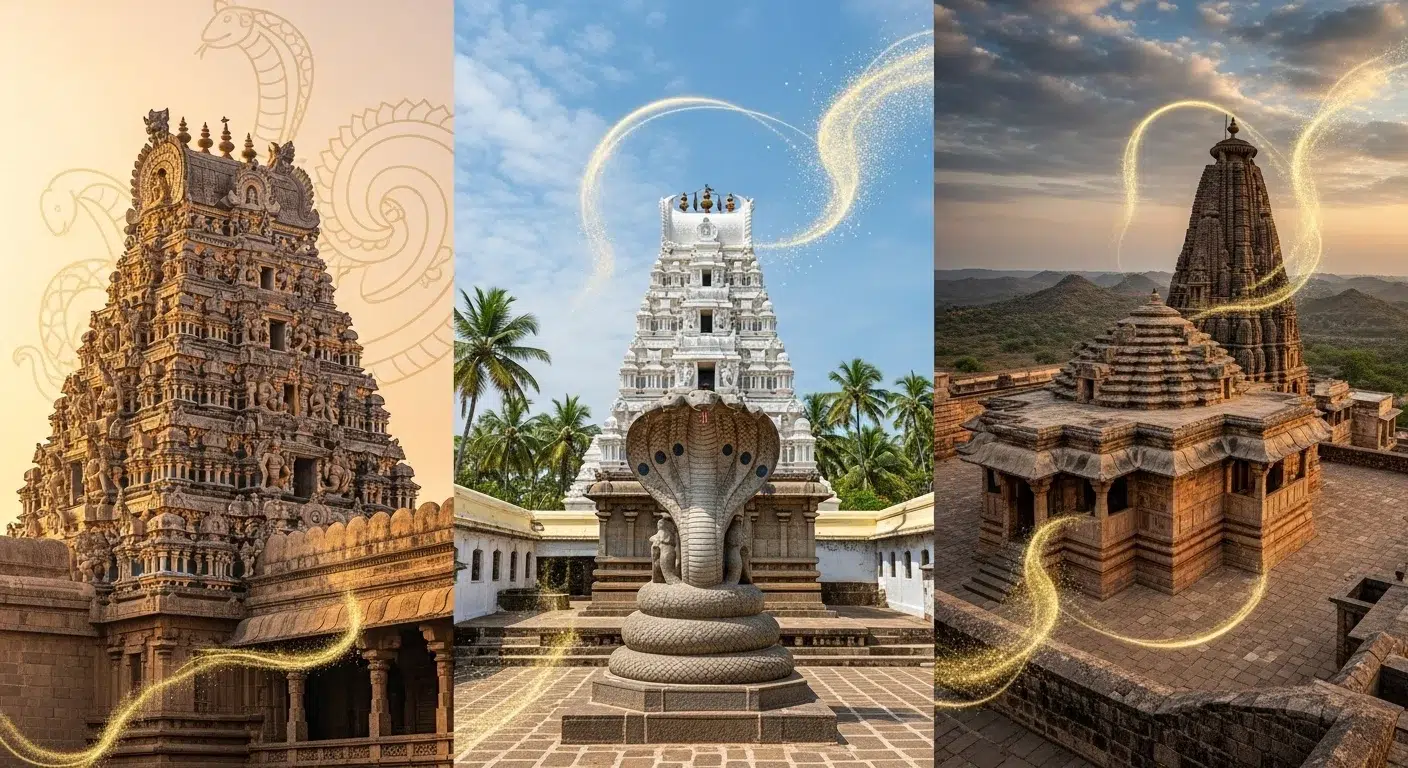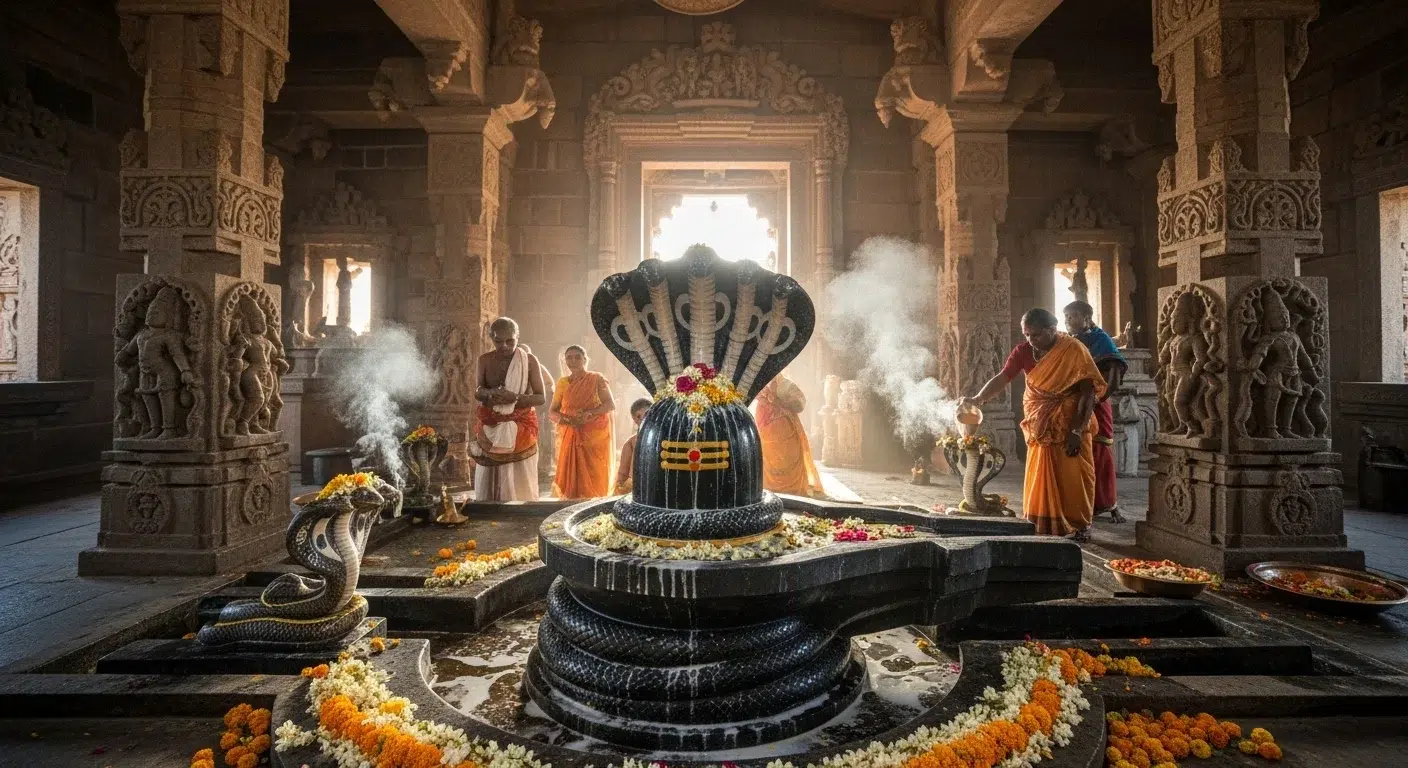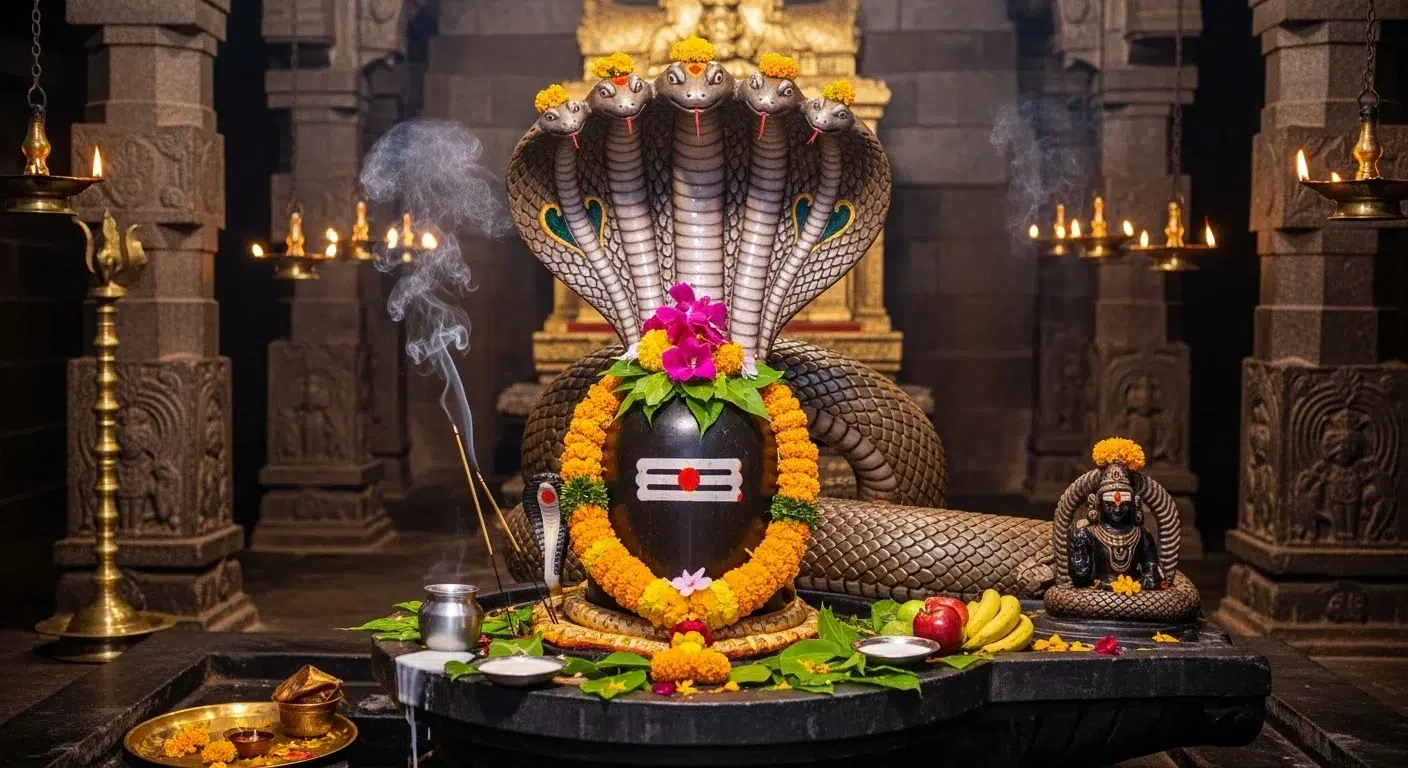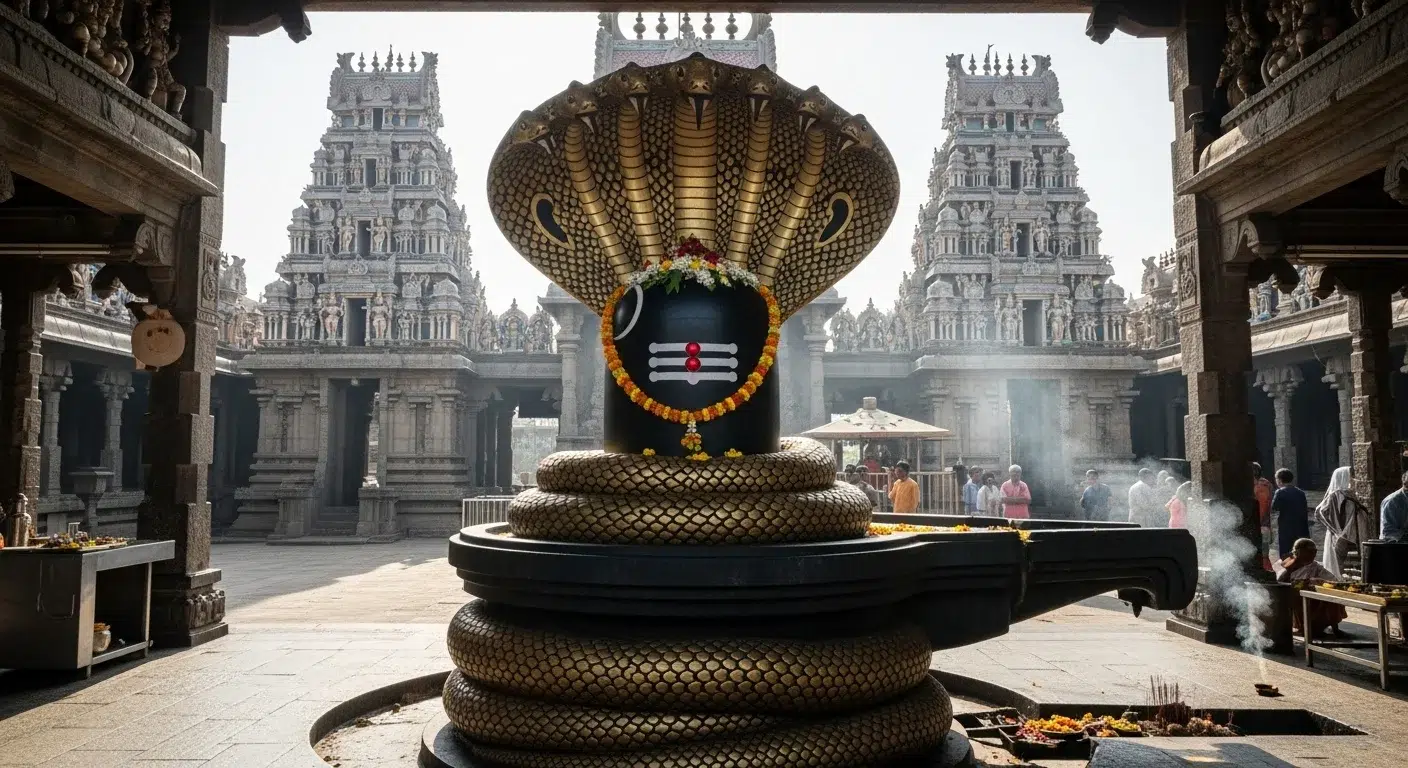Nag Panchami is one of the most sacred festivals in the Hindu calendar. It celebrates the worship of snakes (Nagas) on the fifth day (Panchami) of the waxing half of the Shravan month, which is considered both spiritually significant and powerful in Hindu mythology. In 2025, Nag Panchami is observed on Tuesday, July 29.
The festival is based on the belief that snakes are guardians of life and wealth. Worshippers all over India, pay to either snake idols or snakes themselves with prayers, milk, and flowers to protect them from imminent misfortune, snakebites, and wrongful evil energy. For Nag Panchami, visiting temples that are specifically dedicated to snakes is also an important part of this sacred day.
In this blog, we list the most famous snake temples in India that you can visit to pray at during Nag Panchami 2025.
Why Snakes Are Worshipped on Nag Panchami
Snakes have always had a great place in Hindu mythology.
- Lord Shiva is sometimes depicted with a snake around his neck.
- Lord Vishnu rests on the thousand-headed snake Sheshnag.
- Lord Subramanya (Kartikeya) is the believed protector of snakes.
Snakes symbolize fear as well as fertility. The ancient tradition believes that by worshiping the Nagas it is possible to bring peace to oneself, protect oneself from snakebites and remove hindrances to one’s life caused by planetary doshas especially Sarpa Dosha & Kaal Sarp Dosh.
Famous Snake Temples to Visit During Nag Panchami 2025

1. Mannarasala Sree Nagaraja Temple – Kerala
Nestled in the heart of the forest of Alleppey, this temple of the serpent king Nagaraja, is unique in that women are the priests and has 30,000 serpent idols placed on the premises. It is believed that if one goes to the temple on Nag Panchami, the devotee will gain fertility and have curses removed from their family.
- Special Ritual: Uruli Kamazhthal is performed by childless couples hoping to obtain blessings for childbirth.
- Best Time to Visit: Early in the morning during Nag Panchami, when the temple is decorated and the rituals are fully working.
2. Nagoba Temple – Yavatmal, Maharashtra
Nagoba Temple is holy for the Gond tribal community, which has a fair on Nag Panchami. The temple is dedicated to Sheshnag or the multi-headed serpent god. Both the tribal community and non-tribal devotees offer milk, coconut, and turmeric in devotion to Lord Nagoba.
- Special Ritual: Nagoba Temple combines ancient rituals unique to tribal culture and Vedic practices in a location that offers a value for the cultured visitor.
- Best Time to Visit: Visit Nagoba Temple during October–March for the best weather. For a richer cultural experience, time your trip for Nagoba Jatara in late January or early February, when tribal rituals and performances create a deeply unique pilgrimage event.
3. Naganathaswamy Temple – Tamil Nadu
The temple is situated at a place called Thirunageswaram near Kumbakonam and is the temple of Rahu, a serpent being. The Temple is one of the Navagraha Temples and does a special and elaborate milk Abhishekam (ritual bath) to Rahu during Nag Panchami.
- Special Ritual: It is said that worship here will cure Rahu Dosh and Kaal Sarp Yog.
- Best Time to Visit: The temple gets very crowded in Shravan month. Make sure you book special pujas in advance.
Must Read: Top 10 Iconic Temples That Are A Must-Visit in Tamil Nadu
4. Nag Vasuki Temple – Prayagraj, Uttar Pradesh
Near the union of the Ganga and Yamuna, this site houses an ancient temple to Vasuki, the serpent king. On Nag Panchami, thousands of people come to a Nag temple (in this case Vasuki) to offer sacred prayers and milk.
- Special Ritual: The tranquility of the riverside location adds to the overall spiritual experience. The rituals are performed literally on the banks of the sacred river and the whole experience is spiritual and enriching.
- Best Time to Visit: For the favorable weather and a pleasant temple experience, visit between September and March.
5. Kukke Subramanya Temple – Karnataka
Located in the Western Ghats, Karnataka, this is one of the most frequented snake temples in India. The deity worshipped here, Lord Subramanya, believed to protect snakes and resolve Sarpa Dosha. It also has significant fame as the temple where Sarpa Samskara Pooja is performed – believed to be a strong remedy for curses placed by ancestors.
- Special Ritual: Kukke Subramanya Temple has gained a wide recognition for the various types of puja it has to offer – such as Sarpa Samskara and Ashlesha Bali., to get rid of serpent curses (Sarpa Dosha).Many devotees perform a holy bath in the sacred Kumaradhara River before taking their darshan at the temple.. There are other key rituals performed regularly at the temple, such as, Nagaprathista and daily Panchamrita Abhishekam.
- Best Time to Visit: During Nag Panchami week – when elaborate rituals are performed and thousands of devotees gather.
Must Read: Explore 10 Most Popular Shiva Temples in North India
Rural Snake Worship: A Deep-Rooted Tradition

In addition to the major temples, Nag Panchami is also celebrated across rural India, with rituals surrounding anthills and snake burrows (assumed to be living areas of the Nagas). Villagers draw serpent pictures with white paste or turmeric or some measurements of say, white paste). They give offerings of milk, and recite mantras.
States such as Rajasthan, Bihar, Madhya Pradesh, Odisha and Chhattisgarh have vibrant local traditions associated with revered snakes. These are generally led by women, praying for the well-being and safety of their family.
Mythological Stories Behind Nag Panchami
Several legends support the spiritual essence of Nag Panchami:
- Mahabharata Connection: It is believed that the day marks the defeat of Takshak, the serpent who killed King Parikshit, and the subsequent Sarpa Satra Yajna (snake sacrifice) performed by his son.
- Krishna’s Triumph: Another legend involves Lord Krishna saving his friends from the snake Kaliya, making the day one of gratitude towards him.
Rituals and Practices on Nag Panchami

- Fasting: Many of the devotees keep a fast to honor the god for a complete day.
- Offering Milk: Snakes (or images of snakes) are offered milk, honey, turmeric and flowers.
- Chanting Mantra: Of course chanting Nag Gayatri Mantra or Nag Stotra certainly brings peace and removes fear.
- Drawing Nag Graphics: People do rice (or sandalwood) paste drawings of a serpent at the threshold of their houses.
Conclusion
Nag Panchami is an amazing day to reconnect with nature, recognize its divine forms, and request spiritual protection. The temples listed above are not merely structures but significant holy sites where devotion, faith, and culture come to a culmination spectacularly.
If you want to conduct rituals, conclude doshas, or simply witness the spiritual energy surrounding temples, Nag Panchami 2025 is an ideal opportunity.
Organize your spiritual journey, wear modest clothing, and take offerings according to local customs. People with pure hearts will always find blessings.







